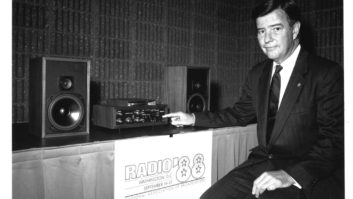Radio Group Is Using HBX Analytics to Measure and Analyze Visitor Activity on Its Large Online Network
(click thumbnail)Pageflow displays allow organizations to visualize and understand the flow of traffic through Web sites.
(click thumbnail)Historical data on contents viewed per visit, new visitors and most requested pages is available on the dashboard.
(click thumbnail)Organic information display of a Web site. White branches thicken as more users visit them or atrophy as they go unused. Orange paths depict the more erratic paths of individual users.
As broadband becomes commonplace and streaming media channels mature, Web sites become an important component of a broadcaster’s overall marketing strategy. Clear Channel Radio’s recent announcement of an agreement with Web analysis specialist WebSideStory Inc. underscores this need for a better understanding of Web activities.
Web Analytics for the Rest of UsYou don’t have to be a large media organization to utilize web analytics. Smaller operations can fine-tune their Internet strategies with a variety of tools and techniques.
Bryan Eisenberg, co-founder of Future Now Inc., said, “Tools for analyzing Web traffic range from Google’s free software through inexpensive programs from Click Trails to more elaborate enterprise-level applications, such as those offered by WebSideStory.”
He said these analytic tools are a separate category from developer programs such as Adobe’s Dreamweaver, which enable users to build Web sites and manage their resources.
Eisenberg identified some simple things stations can do to boost the profitability of their sites. “We hear from a lot of advertisers who want to put ads on station Web sites, but can’t get in touch with them. A surprising number of sites don’t have contact information such as a telephone number and mailing address readily available.”
To many otherwise Web-savvy organizations, analytics remains a black art. The slim list of educational resources on the topic is growing. Eisenberg recommends books by Eric Peterson, “Web Analytics De-Mystified” and Jim Sterne, “Web Metrics.” Eisenberg and Jim Novo have penned a white paper on the topic, “The Marketer’s Common Sense Guide to E-Metrics,” available for free download from www.futurenowinc.com/metricsguide.pdf
The University of British Columbia offers an Award of Achievement in Web Analytics to those who complete a series of four online, part-time courses; Introduction to Web Analytics, Web Analytics for Site Optimization, Measuring Marketing Campaigns Online and Creating and Managing the Analytical Business Culture. Each course is run over approximately four weeks and requires an average of four to eight hours of study per week. Information is available at www.tech.ubc.ca/webanalytics/index.html.
A wealth of information on analytics is available on the Web Analytics Association Web site, www.webanalyticsassociation.org
The challenges for Clear Channel and other organizations with a large Web presence include understanding the relationship between a site’s usage statistics and structure; how visitors’ movement between pages can be expressed in order to understand how some areas are more closely related than others; and how to track the paths that visitors take through Web sites.
These issues are compounded because the contents of most large Web sites are changing continually, with pages being added and deleted on a daily basis, and the sheer volume of numbers generated by most Web logs can be overwhelming and difficult to interpret.
More consistent
The collaboration with WSS will allow Clear Channel to keep a close watch on user statistics for the company’s 1,200 radio station Web sites in more than 221 markets.
Geritt Meier, senior vice president and general manager of Clear Channel’s Online Music and Radio division, said the dual functions of his department are to manage the infrastructure required to operate all of the station Web sites and to provide original programming to those sites, largely in the form of video and text.
“WebSideStory’s HBX Analytics will allow us to analyze what people are watching from Clear Channel Radio’s video-on-demand service, the content being downloaded for podcasts and how many people are watching live station broadcasts,” he said. It will also allow the company to measure the popularity of audio and video content at each site.
Prior to the agreement with WebSideStory, Clear Channel was using a variety of analytic tools.
“They provided some insights into Web traffic,” said Meier, “but didn’t have a good methodology or consistency of data.” He said this type of application would be too complicated to develop in-house.
The partnership also allows Clear Channel to get online reporting from one source. Erik Bratt, director of corporate communications for WebSideStory, said one of the challenges was for WSS to integrate its online visitor information with server data from Akamai Technologies Inc.
“We were able to combine our reports with Akamai’s Edge Control API (Application Programming Interface) to give Clear Channel a more unified view of its online business. WebSideStory has tagged all 1,200 Clear Channel Web sites to provide data on traffic, unique visits, site overlays enabling station webmasters to optimize layout and content flow.”
The partnership was launched in mid-December 2005 and is still in its infancy. Metrics provided by WSS will include a week-by-week growth factor. CC executives can get an overview of the 1,200 Web sites, scope down to Clear Channel’s regions of operation and finally examine performance at the station level. Tools will be added by WSS as they are developed.
Benefits
Meier said the agreement with WebSideStory benefits not only the Online Music and Radio executives, but individual station mangers and webmasters.
“It will enable them to look at the numbers, see what is working and what isn’t and to compare their Web services with those of stations in comparable markets.” He said stations in smaller markets often don’t have the resources to develop a top-notch Web site; now templates and materials will be available to them.
The partnership has paid benefits. Meier said rapid feedback from WSS enabled Clear Channel to take a new Web feature, the Photo Gallery, and fine-tune it for better audience response.
Looking forward, Meier said it’s important for broadcasters to take and integrated view of electronic media, where radio and Web sites are a way to expand the local brand. “The Web is really an extension of a station’s on-air real estate.”
Web analytics is a relatively new discipline. Combining software engineering, information visualization (info viz) and statistics, its goal is to give webmasters information that can improve the effectiveness of their sites. This turns out to be a challenging task.
Traditional site representations such as trees or maps often are ineffective because most sites aren’t truly hierarchical and are in a state of flux. The number of visitors to a page can be tallied, but changing traffic patterns in a Web site make this data of questionable value.
Research on these issues is ongoing at the university level. Information visualization techniques such as Organic Information Design address some of these problems by using a site’s usage data to develop an implicit model of the structure in an interactive, visually refined environment. Users are then able to discern qualitative facts from large quantities of quantitative data generated by dynamic information sources such as large Web sites.















